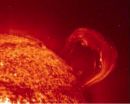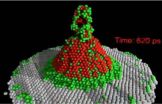(Press-News.org) The findings are based on comparisons of virtual imprints of the developing brain and surrounding structures (known as endocasts) derived from the skulls of modern and fossilized humans, including that of a newborn Neanderthal.
Philipp Gunz of the Max Planck Institute for Evolutionary Anthropology explained that the differences researchers observe in early brain development likely reflect changes in the underlying brain circuitry. It is that internal organization of the brain that matters most for cognitive ability.
"In modern humans, the connections between diverse brain regions that are established in the first years of life are important for higher-order social, emotional, and communication functions," Gunz said. "It is therefore unlikely that Neanderthals saw the world as we do."
Whether cognitive differences exist between modern humans and Neanderthals is the subject of contentious disputes in anthropology and archaeology, he said. Because the range of brain sizes in Neanderthals overlaps with humans, many researchers had assumed that the cognitive capabilities of the two species were similar. The new findings challenge that notion.
In fact, the elongated overall shape of the braincase hasn't changed much in the course of more than two million years of human evolution, despite a big increase in endocranium volume. It is the globular braincases of modern humans that distinguish our own species from our closest fossil relatives and ancestors. The new results show that, at the time of birth, both Neanderthals and modern humans have elongated braincases, but only modern human endocasts change to a more globular shape in the first year of life.
"The distinct globular braincase shape of adult humans is therefore largely the result of an early brain development phase that is absent from Neanderthals," Gunz said.
The research team had earlier found that the developmental patterns of chimpanzee and human brains are remarkably similar after the first year of life but differ markedly immediately after birth. The new findings therefore show that the "globularization phase" of brain development distinguishes modern humans not only from chimpanzees, but also from Neanderthals.
This new view on human brain development might shed light on the results of a recent comparison of Neanderthal and modern human genomes, according to the researchers.
"The uniquely modern pattern of early brain development is particularly interesting in the light of the recent breakthroughs in the Neanderthal genome project, which identified genes relevant to cognition that are derived in living humans," the researchers wrote. "We speculate that a shift away from the ancestral pattern of brain development occurring in early Homo sapiens underlies brain reorganization and that the associated cognitive differences made this growth pattern a target for positive selection in modern humans."
### END
Differences in human and Neanderthal brains set in just after birth
2010-11-09
ELSE PRESS RELEASES FROM THIS DATE:
Fusion makes major step forward at MIT through studies of the plasma edge
2010-11-09
###
These new findings will be presented in three invited talks at the American Physical Society, Division of Plasma Physics 52nd annual meeting on November 8-12 in Chicago. END ...
Getting to know the sun advances fusion research
2010-11-09
Researchers at the Princeton Plasma Physics Laboratory have successfully used Coaxial Helicity Injection (CHI) to generate plasma current and couple it to a conventional current generation method at the National Spherical Torus Experiment (NSTX) fusion experiment. After coupling, the combined process generated 1 million amperes of current using 40 percent less energy than needed to generate this current using the conventional means by itself, thus demonstrating that a high-quality initial magnetic configuration was produced by CHI.
Plasma confinement devices based on ...
Imaging of Alfvén waves and fast ions in a fusion plasma
2010-11-09
Fusion plasmas in the laboratory typically reach 100 million degrees. These high temperatures are required to ignite the hydrogen plasma and maintain the fusion burn by the production of high-energy alpha particles. One challenge for a fusion reactor is how to contain the alpha particles in the vessel long enough for the particles to efficiently heat the hydrogen plasma. One way that these alpha particles can escape the fusion chamber prematurely is by exciting high frequency Alfvén waves and riding these waves to the vessel walls, like a surfer rides a wave to the beach.
While ...
The many faces of the shear Alfvén wave
2010-11-09
When physicists probe the mysteries of plasma, the fourth state of matter, they often discover phenomena of striking beauty. Much as when the Hubble Space Telescope sent back vivid images from space of ionized gas clouds (an interstellar plasma!), new 3D images of shear Alfvén waves are delighting both scientists and a new generation of science enthusiasts.
Plasmas support a large variety of waves. Some of these are familiar, such as light and sound waves, but a great many exist nowhere else. One of the fundamental waves in magnetized plasma is the shear Alfvén wave, ...
Plasma as a fast optical switch
2010-11-09
Just like an electrical switch allows the flow of electricity into electrical circuits, relativistic transparency in plasma can act like a fast optical switch allowing the flow of light through otherwise opaque plasma. Modern day lasers, such as the Trident laser in Los Alamos National Laboratory delivers a 200 terawatt power pulse (roughly 400 times the average electrical consumption of the United States) in half a trillionth of a second (picosecond) time. As shown in Fig. 1, when the laser power reaches a threshold limit, relativistic transparency in plasma turns the ...
Scientists unlock the secrets of exploding plasma clouds on the sun
2010-11-09
The Sun sporadically expels trillions of tons of million-degree hydrogen gas in explosions called coronal mass ejections (CMEs). Such clouds—an example is shown in Figure 1a—are enormous in size (spanning millions of miles) and are made up of magnetized plasma gases, so hot that hydrogen atoms are ionized. CMEs are rapidly accelerated by magnetic forces to speeds of hundreds of kilometers per second to upwards of 2,000 kilometers per second in several tens of minutes. CMEs are closely related to solar flares and, when they impinge on the Earth, can trigger spectacular auroral ...
Taming thermonuclear plasma with a snowflake
2010-11-09
Physicists working on the National Spherical Torus Experiment (NSTX) at the Princeton Plasma Physics Laboratory are now one step closer to solving one of the grand challenges of magnetic fusion research—how to reduce the effect that the hot plasma has on fusion machine walls (or how to tame the plasma-material interface). Some heat from the hot plasma core of a fusion energy device escapes the plasma and can interact with reactor vessel walls. This not only erodes the walls and other components, but also contaminates the plasma—all challenges for practical fusion. One method ...
Vacuum arcs spark new interest
2010-11-09
Whenever two pieces of metal at different voltages are brought near each other, as when an appliance is plugged into a live socket, there is a chance there will be an arc between them. Most of the arcs people see are a breakdown of the gas between the metal surfaces, but this type of breakdown can also occur in a vacuum. This vacuum breakdown, which until recently has not been well understood, has implications for applications from particle accelerators to fusion reactors.
As part of an effort to understand the maximum accelerating field in particle accelerators, scientists ...
PIT(-1)ting good and bad outcomes against each other in breast cancer
2010-11-09
The outlook for patients with breast cancer is determined in part by whether or not their tumor has spread to other sites in the body. A team of researchers, led by Roman Perez-Fernandez and colleagues, at the University of Santiago de Compostela, Spain, has now identified in a subset of patients with breast cancer, a marker associated with the occurrence of tumors at distant sites; a finding that they hope might help predict a patient's outlook more accurately. Specifically, the team found that in patients with breast cancer that was accompanied by the presence of tumor ...
JCI online early table of contents: Nov. 8, 2010
2010-11-09
EDITOR'S PICK: PIT(-1)ting good and bad outcomes against each other in breast cancer
The outlook for patients with breast cancer is determined in part by whether or not their tumor has spread to other sites in the body. A team of researchers, led by Roman Perez-Fernandez and colleagues, at the University of Santiago de Compostela, Spain, has now identified in a subset of patients with breast cancer, a marker associated with the occurrence of tumors at distant sites; a finding that they hope might help predict a patient's outlook more accurately. Specifically, the team ...



